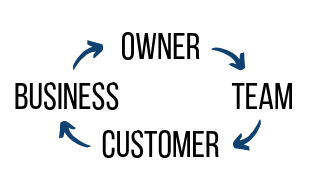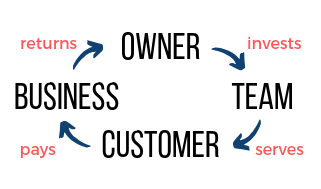14 Team Strategies for Business Owners... that Really Work

I’ve noticed something about business owners....
Most business owners have the same frustrations when it comes to building a high-performing team.
As a Business Growth Strategist, I work with a lot of business owners and I get to hear the same issues over and over again.
Do any of the following comments sound familiar to you?
- “I’m putting a lot of time and effort into managing my team, but my staff won’t take responsibility for their work. Why can’t I attract the right people into my business?”
- “I don’t understand why my competitors are so much busier than me when my work is just as good as theirs.”
- “I feel stuck in this business and don’t know what to do to get unstuck.”
- “Having to do everything myself is preventing me from getting new opportunities.”
- “I don’t really have any plan for how to build my team, so I’m just randomly doing stuff.”
- “I just don’t have any time! I’m working ridiculous hours and not getting home on time. I’m even missing birthdays and important family events! At work I’m just chasing my tail. I feel scattered and I’m having trouble focusing on any project long enough for it to succeed.”
- “I can’t figure out how to make real money from this business.”
If any of these statements resonate with you (and I bet several do), then you’ve come to the right place.
In this post, I’m going to share 14 Team Development Strategies based on work I’ve done with Business Owner clients over the years, that you can start using today, to be a more effective leader.
How do I know these strategies work? Because I’ve seen them work again and again for all kinds of business clients and, implemented correctly, they will work for you.
You don’t need to do them all, but the more you do, the more likely your Team – and your business – will start to gain traction.
If you’d like more hands-on help, simply email me at kevin@ascendency.co.nz and I’ll send you details about how we could work together to get your business really humming.
Now, on to the strategies...
- Invest More in Your Team
When you started in business your main focus was on your Customers. This is natural, you needed customers to generate cashflow.
However, as a business starts to grow, and you employ more people, the business owner (that’s you) needs to shift their focus.
To explain this shift, your business is made up of just four parts: you (the owner), your team, the customers, and the business itself.
For your business to be scalable and to be both sustainable and successful, the four parts must flow in a set sequence. See the diagram below:

This means that you, as the business owner, need to develop your Leadership skills, so you can effectively build and lead a high-performing team. As with sports Teams, high-performing Teams are Winning Teams
Also, to lead a high-performing team, you must provide the members with the resources they need to function. Do they have enough product knowledge, sales skills, and a clear understanding of how to create an amazing Customer experience? Are they clear on their goals?
By investing wisely in your team, making sure they have everything they need to do a great job, they are better positioned to serve their customers. Notice I said, “their customers”? Only when your team takes ownership of looking after who pays the bills – the customer – can your business begin to cultivate ‘raving fans.’ Raving fans are definitely worth cultivating, as they keep coming back to do business, and they also drive referral business to you.
Happy customers pay the business and a profit is earned. From this profit, the business provides you a return on your time, capital, and risk.
Then the cycle continues, for this profit can fund further investment in the team, allowing them to keep on growing and developing, and delighting the customers even more.

Mastering this business cycle sets your team up for greatness. When one of my clients stopped working as a team-member and began thinking as a leader, her whole business changed. “I am now in a position to leave the business in the hands of my acting GM, and take an eight-month sabbatical through Europe with my family,” she said.
For any business owner who feels that they “have no time”, by investing in your team you get your time back.
- Use Your Team When Growing Your Team
Let’s say you have a crucial position in your business that you need filled, fast!
Bright and shiny CVs have flooded your inbox and a couple more candidates have been recommended by your friends. The interview process is over, and your mind is fixed on one particular person.
Their résumé is impressive. They came across self-assured, confident in their experience and ability. They were unflappable as you threw question after question at them. And they can start work immediately. Perfect!
Do not offer them the job.
That’s right – do not make this crucial decision on your own. Why?
Because there’s a good chance you’ve been infatuated, blinded by this candidate’s best behaviour. You’re in love with an applicant who appears to be the answer to all your prayers. In effect, you’re not thinking straight.
So, never, ever hire alone.
Get your team involved, right from the start. Let them help define the vacant role and decide on the attributes a successful hire should have.
Let them read the application letters and CVs. Discuss the merits of each one (or at least reach consensus on the Yes and No piles) and, as a Team, select the people you want to interview.
For the interviews, invite two of your Team to help you conduct the process. Three sets of eyes and ears are far more likely to spot the ways a candidate does or does not fit your business. And three brains can debate the ideal outcome, even if that means walking away from all the interviewees and starting again.
Remember, when you are building a winning Team, no hire is better than the wrong hire.
Even with your Team involved in the interview process, interviews tend to be subjective, so always profile your short-list of applicants. This doesn’t need to be complicated. I have considerable experience with a number of Personality Profiling tools if you’d like support. You can check out the Profiles on my website or shoot me an email at kevin@ascendency.co.nz
But what if you are currently the only person working in your business, and the decision rests on your shoulders?
Get help. Organise a hiring panel: ask your accountant, your best mate, that switched-on guy in your soccer team, your retired neighbour, your mother – anyone with people skills – to help you out. Shout them a coffee. Have fun with the process. And remember, profile your short-list.
Personality Profiling is a very effective instrument that brings a degree of ‘objectivity’ into the interview process (which, by nature, can be very subjective). For general recruiting use the DISC-M Profile and, when engaging Leaders, use the DISC -Leadership Profile.
Just don’t do it alone!
- Embrace the Silence
When you interview candidates, don’t do all the talking.
For some leaders, this can be difficult. Sure, you want to present the job in a favourable light – especially if talent is in high demand – but you still need to learn all you can from your prospective employee.
Fight the impulse to keep speaking. Ask a question (‘open-ended’ questions are great – they can’t be answered Yes or No) and then listen.
Do they give a short answer? Then wait some more.
Raise your eyebrows to indicate you’d like them to expand their answer, or say “Go on…” or “Can you tell me more about that?”
And wait. Don’t be afraid of the silence. Let your candidate fill the void.
You’ll be surprised what you hear when you stop talking.
- Wrangle the Recommendations
References are a key part to building your high-performing team. Except, references are flawed.
Your candidates are only going to give you the names of referees who are going to speak highly of them. Any testimonial letter included in their application is bound to be glowing.
You need to dig a bit deeper.
You want to find out how an applicant works under pressure. What their short-comings are. When things didn’t go right in a previous role, how did they handle it (or not)?
Therefore, when you speak with your short-listed candidate’s old boss or colleague, be ready with a couple of probing questions, like:
- What was the final straw which lead to them leaving that role?
- When did they feel the most pressure to compromise their integrity and how did they deal with it?
- If they got hired, loved everything about this job, and are paid the salary they asked for, what kind of offer from another company would they consider?
Now, you have one further challenge to face: avoiding ‘recommendation reflex’.
Recommendation reflex is that moment when you hear unfavourable feedback about the candidate, and immediately begin to rationalise it so that the information fits your preferred reality.
If you catch yourself thinking “Well, this role is totally different,” or “That was a long time ago,” stop! These are signals that the candidate may not be as perfect as you want them to be. Don’t press on anyway. Face the picture the referees have painted you head-on, even if it feels uncomfortable.
Remember, you have a team with you on the selection panel (Strategy #2), so discuss the referee’s feedback with your panel and be conscious and open-minded in the decision-making process.
Avoid impacting the final selection by reflex. Bringing the wrong person into your Team will seriously impact many levels of your business, including the bottom line. Don’t do it.
- Be Swift When It Goes Wrong
Hiring great people is a skill. A new manager is lucky to get it right half the time, and I’ve worked with executives with decades of experience who were embarrassed with their 80% success rate. Yup, even the old pros can still make hiring mistakes, especially if they don’t use objective instruments like Personality Profiling.
The stakes are high. You want a high-performing Team. You want passionate people and bright ideas. You want shining stars, not black holes.
It doesn’t take long to realise when you’ve made a hiring blunder, does it?
If it’s turning pear-shaped, you must act quickly.
How fast should you move? So fast, it will probably feel like you’re taking care of the hiring mistake too quickly. But a rapid intervention is vital, for everyone.
The first thing to do? Acknowledge you got it wrong.
You can’t blame the employee – you were the one to offer them the job. Don’t wait for things to get better: poor performance or attitude rarely improves with time. The rest of your Team knows there’s a problem and will be looking to you for bold leadership. You owe it to the Team to be decisive. Admitting you made a mistake is not a sign of weakness, it actually builds your credibility. Ignoring the problem erodes that credibility.
The second thing to do? Acknowledge the cost of the mistake.
Yes, it took time and money to bring the new hire on board. There was the induction process, their learning curve, and the subsequent misalignment with expectations. Yes, it will take even more time and money to solve the problem. That’s the price of being in business. You can’t be surprised there.

The third thing to do? Be fair.
Taking bold action does not mean being harsh or unreasonable. Work with the employee to facilitate as smooth and respectful an exit as possible. Remember – every other Team member is watching how you handle the situation.
So, draw in a deep breath and take action. Today.
- Ask Your Team
How are we doing?
That’s a question customers (might) hear quite often, but when was the last time your Team heard it?
Ask your Team to be part of the goal-development process. As well as setting strategies and targets, have them help determine how the company is performing right now. Let them identify both short-comings and successes. Their opinions for company improvement are valuable because they work every day in the gap between how you think the business is doing, and how it is actually performing.
If you are serious about growing a Winning Team, they need to be empowered. Asking them the right questions is a great way to encourage cohesion, engagement, and motivation.
Not sure which questions to ask them? This is something I often handle for clients. If you want to talk about how my survey system can help you, and how to maximise the benefits from the feedback, let me know.
- Dig Beneath the Surface
“Some of the most powerful things we have learnt this year have been to do with our own identity.”
That’s what one of my clients – a married couple – said after they explored their individual strengths and areas of weakness. Suddenly, it became clear to them how they could work in the business more efficiently together and, just as importantly, how they could draw out each team member’s innate abilities.
“Discovering who we are (building our self-awareness) and then working on who we want to be in the future is extremely exciting and motivating,” they said.
Personality Profiling plays an important role in three key areas of your business: recruitment, teamwork, and leadership. However, to fully understand Personality Profiling, you need to understand your own Personal Profile to gain greater self-awareness.
Remember how in Strategy #2 I suggested you involve your team in selecting new members? And how I recommended you add a Profiling tool to the selection process to provide an objective perspective on a candidate’s suitability? When you already have a Team, Personality Profiling is a very effective way to build a high-performing Winning Team.
For more on the Personality Profiles available check out my website.
When each Team Member understands their own personal Profile, they are clear about what type of work they do best, how they prefer to communicate, and how they behave when they are stressed. This understanding goes a long way to generating a Team Culture of respectful communication and effective action.
As a leader, self-awareness is vital for leading with authenticity. It helps you play to your strengths. It points out the areas you need to hone, or delegate. It enables you to be more you.
- Pull Instead of Push
In Strategy #1, I explained how a leader must invest in the Team, providing everything needed for the team to succeed. That includes energy and enthusiasm.
Consider the difference between push and pull. When my sister was young, my parents wanted her to practice the piano. They tried everything, but it all came from ‘push’. Then she heard a song on the radio that she wanted to play – she was inspired. It pulled her to sit down and learn the notes. She was drawn want to practice, instead of being pushed.
When you inspire your Team towards high-performance, you’re not pushing them. You’re pulling them, encouraging them, acknowledging their efforts, giving them credit for their accomplishments and celebrating their successes. When you pull them, they are less likely to – Oh look, something shiny! – be distracted from their goal.
As the Leader, it’s your job to communicate the Company’s Vision, Mission and direction, constantly. It’s your job to keep the Team informed, up-to-date, and on track, with an undercurrent of can-do positivity.
Every high-performing Team feels inspired. They know they are on a mission of great importance. It’s up to you, as Leader, to hold open that space and pull them towards it, willingly.
- Identify the Fear
You want to lead your Team into unfamiliar territory: a new product, a different location, a fresh process.
They’re reluctant.
You take care to share with them what enthused you about the proposed change (see Strategy #8). Rather than talking at your team, you strive to engage with them.
Still they baulk.
Their hesitation may be grounded in fear.
They may not want to go with you on this adventure because – despite their best efforts – they might fail. Or it might be uncomfortable. They’re afraid of the unknown.
No matter how much you want to drive them to move, compulsion won’t address their concerns. Only increasing their ability to succeed will help them.
How do you do that? With little steps.
Create an experience that shows them they can succeed: job rotation, buddy support, personal coaching, additional training. And deliberate practice.
An ability-gap is a master of disguise. Lack of Team motivation might just be fear with a fake moustache.
- Cultivate Cooperation
All Teams encounter conflict at some point. The worst thing you can do, as Leader, is to believe that grown-ups will resolve their differences themselves. If that was the case, there would never be war. Or divorce.
Inside healthy workplace Cultures, high-performing Teams actively address internal differences, swiftly. It’s your job, as Leader, to build and maintain a healthy Culture that allows differences to be raised and resolved.
Also note that innovation and progress come from ideas that are untested, or outside the usual, and Winning Teams embrace healthy conflict. This demands a certain level of maturity, both from yourself and your Team Members. But when your Team understand the business goals and that you have their back (and that you trust them), conflicts can be easily resolved.
What is one action which plants seeds of disharmony in a team? When the Leader encourages unhealthy competition between Team Members, where one Team Member excels at the expense of another. If you are doing this, instead of cultivating a culture of cooperation, your Team will never achieve their goal of high-performance. They will never be a Winning Team
- Stretch Your Team
Do you know the feeling of drudgery when you get up, go to work, come home, sleep, then get up again and repeat the cycle? Over and over and over?
A high-performing Team doesn’t want to experience drudgery. They don’t want to feel as though they are doing something that any other team could do. They want to do the extraordinary. So, challenge them.
Raise the bar! Get your Team to set stretch goals. This will lead them to recognising that they are exceptional individuals. Work satisfaction, engagement, and pride will increase, plus your business will prosper.

Setting stretch goals creates a drive within your Team to do their very best. Your job is to encourage and guide them to achieve ‘the impossible’.
- Be Trusted
Are you trusted? If your Team does not trust you, you cannot inspire them. Nor can you resolve their conflicts. In a climate of distrust your team will not embrace stretch goals, or communicate well. Mistrust is the sand in the fuel tank of a high-performing Team.
I’ve found three areas where trust grows:
1) Relationships
Do your Team Members respect you? Respect cannot be demanded – it must be earned. Building a positive relationship increases trust. Now, don’t confuse being a Leader with always being popular – you may still have to do unwelcome things. But since we trust our friends and distrust our enemies, cultivating strong relationships is beneficial.
2) Knowledge / Expertise
Do you assist your team to solve problems? Sharing your experience, skills and insight increases trust. You don’t need to have all the answers; however you do need to be part of the solution, not part of the problem. When you build a healthy workplace Culture that supports different ideas, trust increases.
3) Consistency
Say what you’ll do – then do it – then repeat, and repeat. Following through, being dependable, walking your talk: this builds your level of trust within the Team. After all, your Team want a Leader they can rely on in all situations. Is that you?
- Ask for Help
Being a Leader can be daunting, nerve-wracking, even isolating. It doesn’t need to be.
Many people in business feel they have to do everything themselves. They find work all-consuming. Frustrating. Draining.
High-performing Leaders know that it’s okay to ask for help.
Is there someone experienced who would be happy to mentor you? Can you join a mastermind group for mutual support? Or would you prefer the direct engagement of a Business Coach, Executive Coach or Business Growth Strategist?
It can feel daunting to reach out for help, however all great Leaders understand that this is their greatest leverage. Whatever form of support you decide on, this is the kind of outcome you can likely experience:
“I am looking at the best financial year my business has ever had. I now have vastly increased business and personal knowledge, plus a corresponding huge leap in confidence in my own ability”. SB
“I set four major business goals to achieve in my first six months of business. I have achieved three of them and I am working on completing the fourth within the six-month timeframe”. RBP
Short-term or long-term, seek out the support you need.
- Think long term
Ok, I know we have covered a lot. Now we’ve reached the last strategy!
You certainly don’t have to follow all the advice I laid out above, but whatever you decide to do make sure you’re consistent, stick with it, and recognise that building a high-performing Team takes commitment and is a long-term game.
It’s not about quick-fixes (which are bound to frustrate everyone), it’s about building something authentic and genuinely valuable. It’s about building a Team who truly cares about their work and will work hard to delight their customers – which are your customers.
These 14 strategies will help you to move your business forward.
If you feel like you could use some additional help figuring out where to start and what to do, shoot me an email at kevin@ascendency.co.nz nd we can make a time to talk.
I am committed to your success and want to see you realise the full potential of your business.
One more thing...
I spent hours writing this because I want to help as many business owners as possible. I know it can be hard and lonely out there, and it’s frustrating to see so many talented business owners and executives not getting the results they deserve from their Team, simply because they don’t currently have the skills.
So, if you found these strategies helpful, I’d love it if you would share this post with anyone who could benefit from it directly, or, share it on your social media platforms.
And please contact me if you would like to have a no-obligation chat.
To Your Success,
Kevin
Kevin Heppleston